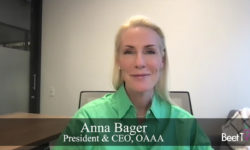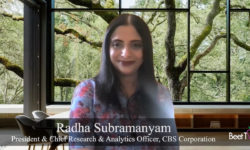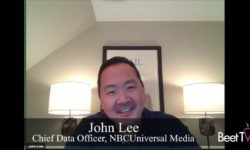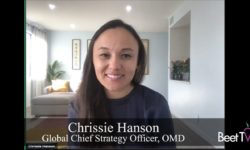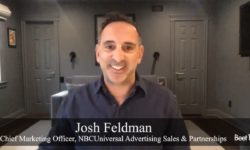Advertising has always been part of the attention economy, a concept that is at least as old as the web.
Recently, after a couple of decades of measuring consumers’ actions, sections of the marketing industry are striving to re-value media inventory in line with consumers’ attention.
But how do you measure and price attention accordingly? In this video interview with Beet.TV, Dentsu Media’s Americas CEO Doug Rozen explains how his agency thinks it has figured out the formula.
Rediscovering attention
Dentsu’s own research into the economics of attention, over the last three years, has led it to introduce a new, attention-based media currency, the effective attention cost per a thousand (EACPM).
It started with the agency’s first research report on the topic, The Attention Economy, in 2019, which analyzed panel members’ consumption across a range of ad types (linear TV, in-feed social video, pre-roll ads OTT) and also used smartphone camera eye tracking to collect real viewability data.
Rozen tells Beet.TV that identified two findings:
- There are shades of attention: “A full gaze of an ad is not the only gaze that matters. Low-gaze, a quick glance or a peripheral glance as you’re co-viewing or doing something else still actually provide considerable value, and this is true across all platforms.”
- Wide is as good as long: “More of an ad that is seen is as equal to the effect of how long an ad is.”
Human attention & ad viewability are not the same. It's why we believe attention-based value systems will revolutionize the way we all plan, buy and measure media like never before. Great work from @dentsuintl.https://t.co/KZKAHDSM9g
— doug rozen (@DougRozen) October 21, 2021
The new currency of concentration
Out of those learnings, Dentsu is trying to operationalize “attention” for a media world in flux.
“We’ve taken all of this work a step forward and built a model based on tens of thousands of inputs to use in media planning,” Rozen says.
“We know the attention seconds per thousand now across display and video from walled gardens to VOD and beyond.
“We built a recall model looking at five values that lead to expected uplift. By combining all of this together, we’re able to create this new currency. It’s really groundbreaking because it allows us to properly value video formats based not only on attention, which in and of itself is fantastic, but the effectiveness of that attention relative to the cost of the unit.
“Where this plays out is shifting from a traditional CPM to what we’re calling a new metric, an EACPM, an effective attention cost per a thousand.”
Snapchat Commercials Pass the Eye Test in Dentsu’s Attention Economy Research: https://t.co/asET3tPaDu @dentsuintl #dentsu #attentioneconomy #snapchat pic.twitter.com/9IWY7OwMOK
— Social Pro Daily (@SocialProDaily) October 27, 2021
Attention under assault
Whilst metrics like viewabilty have tended to focus on how the technical framing of an ad makes for the possibility of it being rendered on screen, the real attention given by consumers to an ad has remained murkier.
Meanwhile, many premium publishers are trying to pivot the industry away from traditional buying metrics, toward a measurement technique they feel is more their strong suit, attention.
For Dentsu’s Rozen, the need is now clear.
“The average person is exposed to between six (thousand) and 10,000 ads every single day,” he says. “That’s twice the amount that it was in 2007 and far, far, far from the 500-ish in the 1970s.
“Forty-two percent of internet users worldwide are using an ad blocker. People, their attention span is now less than 10 seconds. Six seconds and 15 seconds have become dominant.
“Our attention is under assault, and yet we continue to trade on reach, on impressions, and so we’re asking ourselves, ‘Why is that?’
“Audience intention is just no longer a given – it’s something I believe we must earn. We all are watching more Netflix with less ads. We have to think about things differently.”
You’re watching “Advertising Transformation: What’s Next for Converged TV + Video,” a Beet.TV Leadership Series and Summit presented by Mediaocean, produced virtually during CES 2022. For more videos from this program, please visit this page.






